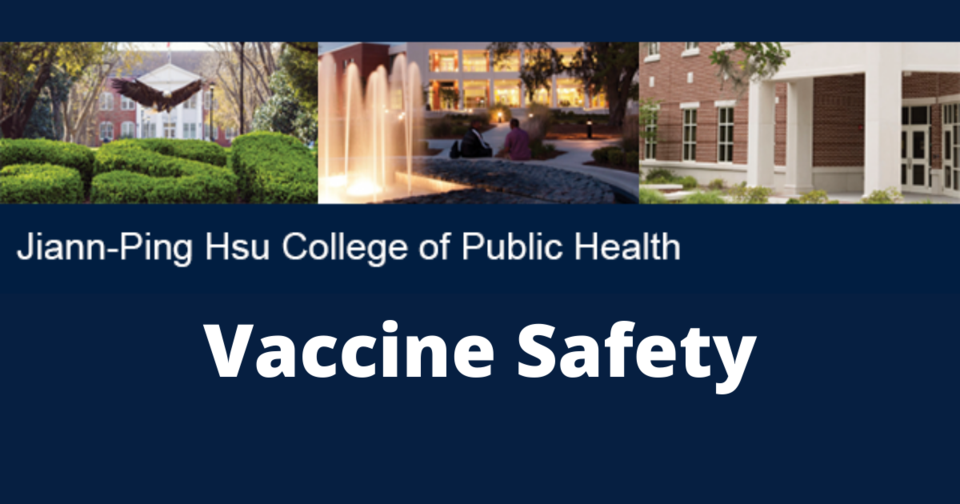With so much confusion regarding the COVID-19 vaccine development, Grice Connect reached out to local experts to help explain the pharmaceutical industries role in developing safe and effective vaccines for decades. Karl E. Peace, Ph.D. and Mario Keko, MPH, Jiann-Ping Hsu College of Public Health submitted this detailed response explaining the safety of vaccine development.
What is Public Health?
Many ask: “What is Public Health”? Invariably answers to the question include a contrast between medicine and public health practices, pointing out that medicine deals with the individual whereas public health deals with populations and that medicine is primarily aimed at treatment while public health is primarily aimed at prevention.

We prefer to think of public health as any intervention (educational, behavioral, policy, treatment, or prevention) aimed at improving the health of the public, i.e. public health is health of the public.
Pharmaceutical Industry Role
It is not difficult to accept that the Pharmaceutical Industry (PI) has been and continues to be a major contributor in improving public health, which is credited to having added 25 years to life expectancy in 20th Century.
When considering CDC’s Ten Great Public Health Achievements to be mentioned is that PI has played, among others, a great role in Immunizations, control of infectious diseases, and declines in deaths from heart disease and stroke.
14 Diseases Impacted Thanks to Vaccine Development
Regarding immunization, CDC lists 14 diseases that we have nearly forgot about due to the success of vaccines in creating immunity against them (CDC, 2020), showing again the PI impact in disease prevention through vaccine development.
These are:
- Polio
- Tetanus
- Flu (Influenza)
- Hepatitis B
- Hepatitis A
- Rubella
- Hib (Haemophilus influenzae type b)
- Measles
- Whooping Cough (Pertusis)
- Pneumococcal Disease
- Rotavirus
- Mumps
- Chickenpox
- Diphtheria
PI has also developed numerous medicines to control other infectious diseases. In the 35 years since the first antiviral azidothymidine (AZT) for the treatment of HIV infections received FDA approval, both the quality and quantity of life has improved among HIV and AIDS patients from AZT and its folllowers.

There are currently more than 400 drugs or vaccines under development for the control of infectious diseases, including 49 against HIV and 42 against COVID (Pharmaceutical Research and Manufacturers of America, 2020).
Deaths from heart disease and stroke have declined considerably in the last 3 ½ decades, explained to some degree by the availability of medicines developed by PI.
In treating stroke, t-PA, if given within 3 hours of the stroke can prevent further damage and lead to marked improvement.
Antiplatelet drugs as well as anticoagulant drugs or blood thinners also contribute to better health of the stroke patient. Controlling high blood pressure and cholesterol levels leads to a reduction in the risk of Myocardial Infarction (MI) and death.
The drug Lopid (a Warner Lambert/ Parke Davis compound), in the landmark Helsinki Heart Study, was the first to be approved for lowering the risk of MI among Finnish men with high cholesterol, and to validate the lipid hypothesis (raising HDL and lowering LDL leads to reduced risk of MI).
These are but three areas of pharmaceutical R&D that have produced drugs and vaccines that have a tremendous positive impact on public health. There are many others.
Since the approval of the first H2-receptor antagonist Cimetidine, ulcer disease has become more manageable and less costly. Similarly, many drugs for the treatment of diabetes have improved the quality and quantity of life of the diabetic patient.
The process of Pharmaceutical Research and Vaccine Development
Pharmaceutical R&D begins with the identification of lead compounds, which are then subjected to rigorous research in vitro and in vivo to determine if they should be elevated to clinical development status.
If so, the pharmaceutical company files an Investigational New Drug (IND) exemption with the Food and Drug Administration (FDA). Then the clinical development plan is formulated showing what studies in humans (Clinical Trials) will be conducted in Phase I, Phase II and Phase III.
Once the clinical trials have been completed, analyzed, interpreted and compiled as a New Drug Application (NDA), the company files the NDA with the FDA for regulatory review and hopefully for approval.
Getting a drug approved for use by the physician is a lengthy and expensive process. Estimates of the time required to take a new drug from initial laboratory studies through the clinical development program and FDA approval range from 8 to 15 years; with an average cost per drug of about $1 billion.
In 2014 the governments being represented by the Organisation for Economic Co-operation and Development (OECD) invested USD 51 billion on health related R&D, while the Pharmaceutical industry invested USD 100 billion (OECD, 2017).
The greatest spending takes places in USA, with the government investing USD 33 billion (0.2% of GDP) and PI USD 56 billion (0.3% of GDP) (OECD, 2017). Being highly R&D intensive, in 2014 the industry in OECD countries spent on average around 14% of its gross value added on R&D (OECD, 2017).
PI contributes to emergency preparedness through the Rx Response program under the auspices of the Pharmaceutical Research and Manufacturing Association (PhRMA). It has put a great effort in redirecting their R&D capabilities towards development of treatments or vaccines as a solution in facing the current global challenge of COVID-19.
COVID-19 Vaccine Development
Since as early as March 2020, there were 23 companies researching vaccine and treatment candidates against COVID-19. This resulted in companies receiving Emergency Use Authorization (EUA) for their vaccine candidates after the rapid completion of Clinical Trials on Efficacy like Pfizer and Moderna on 11th and 18th December 2020 from FDA, and AstraZeneca/Oxford on 29th January 2021 from European Medicines Agency (EMA) and later on 15th February 2021 from WHO.
To be noted is the tremendous reduction of time between vaccine candidate proposal and EUA. Furthermore, 20 vaccine candidates are currently under review from large-scale efficacy tests and 6 more in early or limited use (The New York Times, 2021a).
PI has also paid attention to the challenge of increasing production scale to meet the emergent needs. Pfizer reports increasing the efficiency of its vaccine production that results in halving the production time (USA TODAY, 2021); Moderna has received approval from FDA to put 14 doses in each vial instead of 10, which results in increased vaccine stock (The New York Times, 2021b). Lastly, coordination of vaccine production with efforts from Public Health agencies to deliver and administer them has made it possible to have high vaccination rates.
Note: A version of this article is published at Eagles Talking About Public Health, https://jphcoph.georgiasouthern.edu/opr/etaph/




